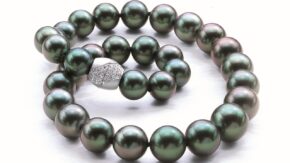Advances in technology means treatments are becoming harder to detect, forcing gem labs to play detective to keep up.
Treatments used to enhance the color or clarity of a diamond are not new. In fact, scientists have been toying with techniques since the turn of the 20th century. Over the years, advances in technology and increased demand for lower priced gem materials have contributed to the rise of new treatments.
This has led the industry to a consensus on a variety of treatments for natural diamonds, which are outlined in The Diamond Book by CIBJO, The World Jewellery Confederation. These range from laser drilling and fracture filling to improve the clarity of a diamond, to heating and irradiation or high pressure – high temperature (HPHT) processes for color enhancements.
Techniques for improving diamond clarity are less of an issue today because they are readily identifiable, says GIA lab director Tom Moses. “I’m not so sure there are fewer clarity-enhanced diamonds on the market, they’re just less of an issue when it comes to detection,” he explains. Color enhancements, on the other hand, leave labs playing detective to uncover changing recipes of treatment procedures.
Gem labs and equipment manufacturers are being diligent in their ongoing efforts to detect these treatments to protect consumer confidence and safeguard against those that slip through the cracks undisclosed. More than ever, proper disclosure is imperative for the trade since wrongdoers are constantly developing innovative ways to hide their treatments to enable a higher grading than the diamond deserves.
COCKTAIL OF TREATMENTS
A new and growing trend in diamond enhancements is the use of a “cocktail” of treatments, according to Branko Deljanin, research gemologist at CGL-GRS Swiss Canadian Gemlab. “For 20 to 30 years it was common to use one treatment,” he says. “But in the last decade, treatment facilities are using several techniques that make detection more complex.
There are also post treatments, especially on colorless type IIa diamonds, intended to hide identification features so that less experienced gemologists or appraisers would issue a ‘natural color’ certificate.”
We’re seeing more synthetics on the market that can be irradiated and annealed to produce pink.
Branko Deljanin, research gemologist at CGL-GRS Swiss Canadian Gemlab
Treatments combining HPHT, radiation, annealing, and even surface coating, aiming to alter the color of a diamond, have gained in popularity in the past ten years, says Deljanin. A rainbow of colors is now possible, including more pinks, and rare reds, blues and greens. While most color treatments are stable, there are some that are not — like surface enhancements, which are seen more in pink diamonds to achieve an intense fancy color.
These combinations are also being used in synthetic diamonds, Deljanin says. “We’re seeing more synthetics on the market that can be irradiated and annealed to produce pink,” he explains. “They grow the diamond in one color, with yellow the easiest to grow, and then irradiate and heat the stone to make it pink or red. Treated synthetic pink diamonds can look natural.”
It’s very common that the goal of treatment facilities is to produce natural looking pink diamonds because prices of pink diamonds are higher than other colors, Deljanin notes.
DETECTIVE WORK
The absence of pink graining with higher magnification in larger stones is an indication the color is not natural, but it’s almost impossible to see these features in very small stones, says Deljanin. As a screening technique, he explains you can separate natural pink melee under ultraviolet (UV) light. Natural always fluoresces blue stronger under longwave than shortwave light, while treated fluoresces orange and synthetics red, with the same strong intensity under both longwave and shortwave UV light.
Natural always fluoresces blue stronger under longwave than shortwave light.
Deljanin says most multistep diamond treatments and synthetic diamonds can be identified on the basis of their long and short UV and phosphorescence reactions with reference to some descriptive or pictorial guidelines.
Alternatively, they can be identified by learning from practical workshops with the use of a microscope, spectroscope, and cross polarized filters.
HPHT enhanced, irradiated green and post annealed yellow (and other color) diamonds and chemical vapor deposition (CVD) synthetic diamonds are not always easy to identify with standard instruments only, and advanced spectrometers are often used to confirm color origin.
Regarding surface coatings used to create a desirable fancy color or whiten off-color diamonds, they can be detected by applying a carbide scriber on a facet surface, says Antoinette Matlins, gem and jewelry expert, author, and consumer advocate.
A coated stone will show what looks like a scratch, whereas a non-coated diamond will show nothing because a carbide scriber cannot scratch a diamond, she notes.
With such “destructive tests” not allowed in gem labs, careful examination under a microscope can often reveal the absence of color at facet junctions where very thin coating applied wears off, especially on the pavilion, Deljanin says.
However, as enhancements continually become more scientifically complex, gem labs are increasingly looking to sophisticated scientific instrumentation to sort natural diamonds from those that have been tampered with.
And it would appear that as technology continues its advance, the cat and mouse game between labs and crooks in the diamond industry is, sadly, likely to escalate rather than disappear.
The Seven Golden Rules to Ensure Your Diamond Is Untreated
- Know your seller and work with
reliable sources. - Insist on a report from a knowledgeable, capable lab for significant diamonds, quarter carat or above.
- Keep up with gemological
literature and stay current on what’s happening in the market. - Screen material you’re buying. Work with small instruments like a UV mini lamp with magnifier to help separate natural from treated and synthetic.
- Learn how to use a spectroscope.
- Have your supplier check loose melee diamonds with a lab. It’s more of a problem to find parcels mixing treated and synthetic with natural.
- Cost of testing mounted melee diamonds in labs is too high and complex, so it’s better for dealers/
jewelers to use a UV light to screen out most treated and synthetic diamonds, and then send for certification.




